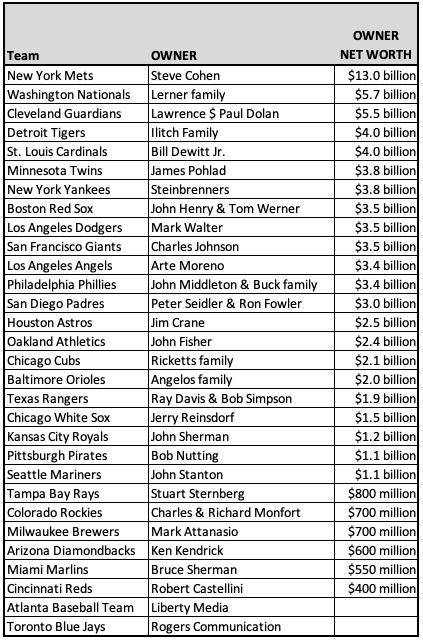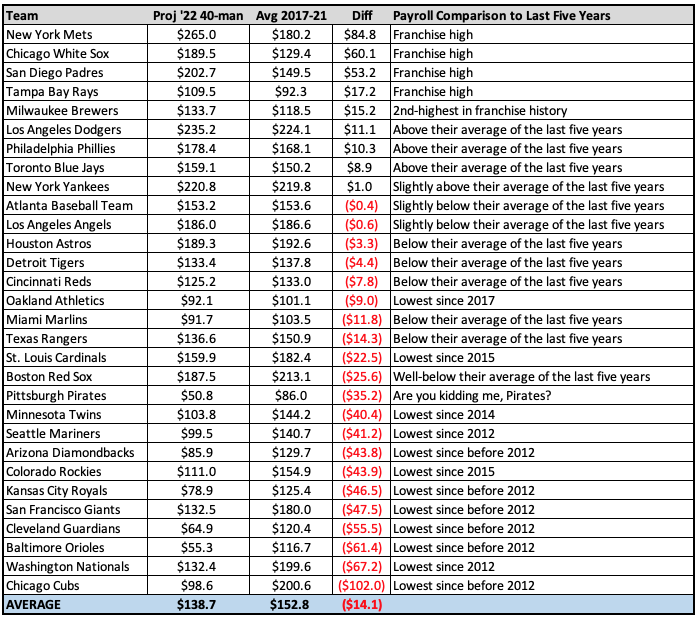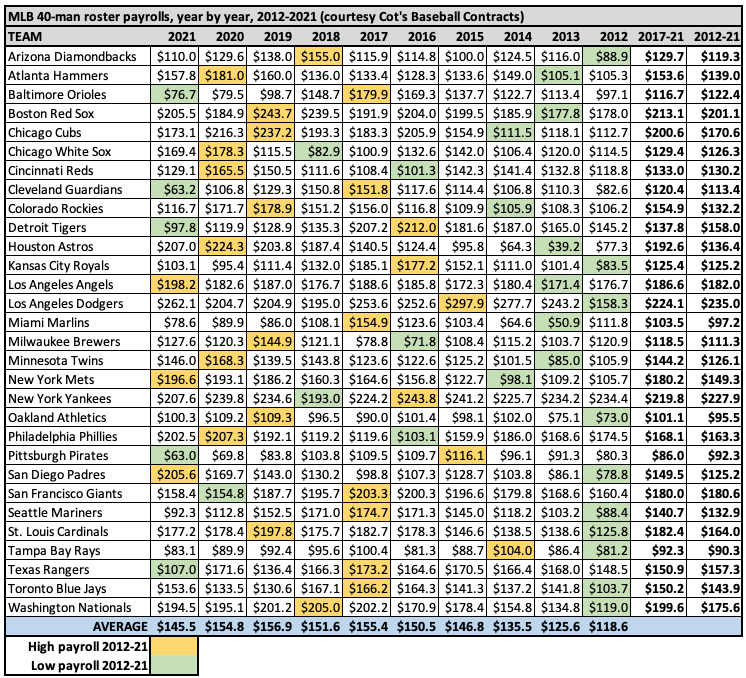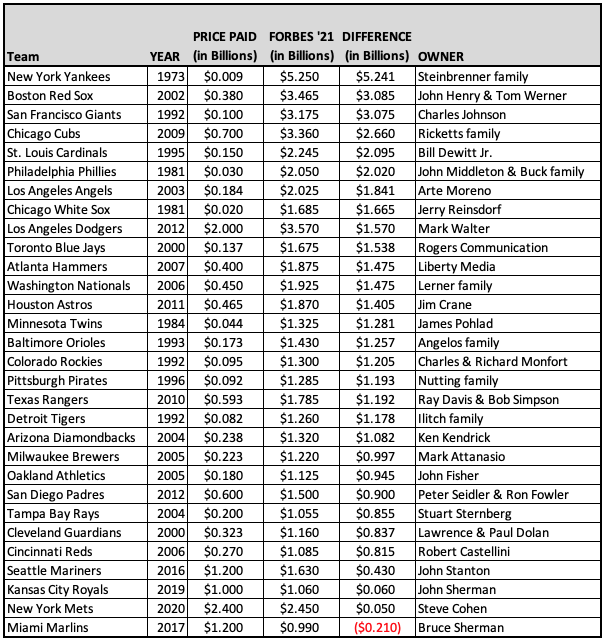Let’s Talk About Major League Baseball Owners

Now that the MLB owners have officially locked out MLB players, let’s talk about the owners a bit. Well, first, let’s talk about Rob Manfred, the owners’ mouthpiece. One important thing to remember during this work stoppage is that the commissioner of baseball, Rob Manfred, works for the owners. Some fans have the misconception that the commissioner is an impartial, completely objective overseer of baseball. He most definitely is not.
The commissioner works for the owners, gets paid $11 million per year to do so, and does what the owners want him to do. He is decidedly on their side. This is not MLB owners on one side and MLB players on the other, with the commissioner in a neutral position in the middle. This is MLB owners AND the commissioner on one side and MLB players on the other. Keep that in mind whenever Manfred puts out a statement. He’s speaking solely for the owners.
Please Don’t Confuse Millionaires with Billionaires
One common complaint from baseball fans during labor strife is: “We’re sick of millionaires fighting billionaires.” That may seem reasonable on the surface, but it doesn’t take into account the vast difference between millionaires and billionaires:
- A million seconds is about 11.5 days. A billion seconds is about 31.5 years.
- Spending one million dollars in a year would require spending $2,740 per day every day. Spending one billion dollars in a year would require spending $2.7 million per day every day.
They’re just not even remotely in the same ballpark, so please don’t act as if they’re equal. In addition, not all MLB players are millionaires because most players don’t have long careers. Many are out of baseball by the time they reach 30, after having been paid below-market wages for most of their careers and below-poverty wages while in the minor leagues. According to Travis Sawchik, in 2019, pre-arbitration players—those getting paid the least—”accounted for 53.6% of days of service time accumulated, but only 9.8% of player pay.”
Also keep in mind that you love your team much more than the billionaire owner does. Many of you have grown up supporting a team since you were kids. You’re loyal. You stick with your team in good times and in bad, you get to know the players and announcers, you go to the ballpark if you can afford it and watch games on TV or your phone or listen on the radio when you can’t be there in person. In contrast, many billionaire owners see the team as a money-making operation, prioritizing profit over the product on the field. Some owners are corporations driven solely be shareholder value.
“Dollars and Cents are an Incarnation of our Values”
Also, let’s not compare the salaries of baseball players to teachers or firefighters or nurses or grocery store clerks dealing with unruly customers during a pandemic. In a more equitable world, we wouldn’t have massive disparities in how much people earn and CEOs wouldn’t make 351 times the salary of the typical employee. We don’t live in that world. We live in this world, which Bill James described well in one of his essays:
One of the unwritten laws of economics is that it is impossible, truly impossible, to prevent the values of society from manifesting themselves in dollars and cents. This is, ultimately, the reason why we pay athletes so much money: that it is very important to us to be represented by winning teams. The standard example is cancer research; letters pop up all the time saying that it is absurd for baseball players to make twenty times as much money as cancer researchers. But the hard, unavoidable fact is that we are, as a nation, far more interested in having good baseball teams than we are in finding a cure for cancer.
That pool of money which we pour into athletics makes it inevitable that athletes are going to be better paid than cancer researchers. Dollars and cents are an incarnation of our values. Economic realities represent not what we should believe, not what we like to say we believe, not what we might choose to believe in a more perfect world, but what our beliefs really are. However much we complain about it, nobody can stop that truth from manifesting itself.
—The Mind of Bill James (p.216)
MLB players are the best in the world at what they do and they generate billions of dollars of value for the sport. That’s the reason they get paid so much. Also, unlike other occupations, they don’t get to choose where they work until many years into their career, if they last long enough in the sport. They get drafted right out of high school or college and have essentially no recourse but to sign with the team that drafted them. We would never force the best young doctors coming out of medical school to be drafted by a hospital and then forced to work there for the next 10 years.
Just How Many Owners are Billionaires?
In the current environment, most MLB teams are owned by billionaires. And despite what they may claim about losing money (without producing evidence), they’re all either making money every year or will make a huge profit when they sell the team. The following chart was created using information from an article at Forbes magazine,

That’s a whole lotta cabbage. Two major league teams are owned by media companies. Twenty-one of the other 28 are owned by billionaires. This includes the Pittsburgh Pirates, with their laughable payrolls, which brings us to the chart below that shows the projected 2022 cost of each team’s 40-man roster compared to the average cost of their 40-man rosters from 2017-2021. This information comes from Cot’s Baseball Contracts.

Some of the 2022 numbers will change once the lockout has ended and more players are signed, but as of right now we see that just nine of 30 teams are projected to spend more on their 40-man rosters in 2022 than they spent on average over the previous five seasons. One-third of the league is projected to spend significantly below that average.
You may be thinking, ‘Yeah, but owners lost money during the pandemic, so they need to cut payroll.’
NEED to cut payroll? Not really. Consider this: when teams make more money during a particular season they don’t give players big bonuses. They bank that profit. In the years leading up to the pandemic, teams were banking profits. If they lost money during the pandemic that doesn’t mean players need to share in the loss. No business is guaranteed to make money every year, but workers still deserve to get paid.
Yearly 40-man Payrolls From 2012-2021
If you’re interested in the payroll of your favorite team over the last decade, the following chart shows each team’s 40-man payroll from 2012-2021, with their maximum payroll highlighted in yellow and their lowest payroll highlighted in green. The average payroll per team is at the bottom and reveals that salaries have plateaued since 2017, which was the first season after the previous CBA was agreed upon in November of 2016. Contrast that plateau with the previous steady increase in payrolls during the 2012-2016 CBA that was signed in November of 2011. Major League Baseball revenues have increased immensely over the last five seasons, yet payrolls haven’t followed suit. That’s just more money in the wallets of billionaires.

One last thing to remember is that the values of baseball franchises have consistently increased over time. Thanks to Forbes magazine, the chart below shows how every franchise but one has appreciated during the reign of current ownership, sorted by the greatest increase to the least.

Notes:
- Boston Red Sox—purchase included control of the New England Sports Network.
- Chicago Cubs—Ricketts purchased 95% stake in Cubs and 25% stake in Comcast SportsNet Chicago.
- Houston Astros—purchase included 60% share in Houston Regional Sports Network and $70 million rebate for moving club to American League.
- San Diego Padres—Fowler and Seidler bought the Padres and 20% stake in Fox Sports San Diego for $800M in 2012.
- Seattle Mariners—Nintendo retains 10% stake in club.
- Kansas City Royals—previous owner David Glass bought team for $96 million in 2000 and sold for $1 billion in 2020.
- New York Mets—previous owner, the Wilpons, bought 50% stake for $391 million in 2002, sold for $2.475 billion in 2020.
- Miami Marlins—previous owner Jeffrey Loria purchased club for $143 million in 2002 and sold for $1.2 billion in 2017.
As you can see, most of these franchises have increased in value tremendously. For the three most-recently sold franchises—the Marlins, Royals, and Mets—I included a note above showing how much those franchise increased in value under previous ownership.
One Last Thing
In recent years, billionaire baseball owners have successfully convinced some fans to care about their team’s payroll, which doesn’t make much sense because the team’s payroll is not coming out of the fan’s pocket. NOTE: ticket prices are a matter of supply and demand and not based on payroll. Ask yourself, ‘When was the last time a team slashed payroll costs in half, then slashed ticket prices as well?’ That would be never. Ideally, MLB owners and the MLBPA will agree on a new CBA before it impacts the 2022 season. In the meantime, be wary of anything you hear from billionaire owners and the media companies they influence, which includes national baseball reporters known to be mouthpieces for ownership, commissioner Manfred, and the people on MLB Network, which is owned by MLB. Finally, remember that you are baseball fans, not the GM of your favorite team. Don’t worry about how much it costs the billionaire owner, just root for your team to put their best effort into winning games, making the playoffs, and hopefully earning a World Series championship.
















